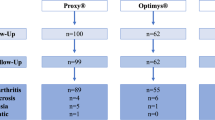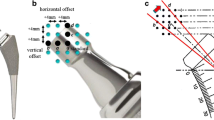Abstract
Introduction
Restoration of the physiological biomechanical principles of the hip is crucial in total hip replacement. The aim of this study was to compare an arthroplasty system with different offset options (a: Exeter®) with a dual-modular stem (b: Profemur Xm®).
Materials and methods
A local and an inertial coordinate system were used to assist the description of the components’ assembly in the prosthesis. A resection line of the femoral head in standard position was added to the arthroplasties and geometric parameters were measured. The outcomes of 93 patients were clinically evaluated (a: n = 50, b: n = 43). Preoperative planning was compared to postoperative radiographs (femoral offset, leg-length), and clinical scores (HHS, WOMAC, total range of motion) were assessed preoperatively, and then 1 and 2 years after surgery.
Results
The Exeter® offers an offset range from 32.1 to 56.9 mm and the Profemur Xm® a range from 29.3 to 55.3 mm. The leg-length variability of the Profemur Xm® has a range of 25.9 mm, the Exeter® a range of 13.7 mm. The Profemur Xm® offers more possible combinations of offset and leg-length reconstruction. The neck–stem angles of the Exeter® range from 125.2° to 126.3°, of the Profemur Xm® from 127.2° to 142.6°. There was no statistically significant difference in clinical outcome and radiological parameters.
Conclusions
We conclude that both stems offer a wide range of options for anatomical reconstruction of the hip resulting in similarly good clinical results. The Profemur Xm® stem has advantages for the reconstruction of hips that deviate from standard anatomy but has the drawback of additional corrosive wear at the stem/neck interface.



Similar content being viewed by others
References
Asayama I, Chamnongkich S, Simpson KJ, Kinsey TL, Mahoney OM (2005) Reconstructed hip joint position and abductor muscle strength after total hip arthroplasty. J Arthroplasty 20(4):414–420. doi:10.1016/j.arth.2004.01.016
Asayama I, Naito M, Fujisawa M, Kambe T (2002) Relationship between radiographic measurements of reconstructed hip joint position and the Trendelenburg sign. J Arthroplasty 17(6):747–751
McGrory BJ, Morrey BF, Cahalan TD, An KN, Cabanela ME (1995) Effect of femoral offset on range of motion and abductor muscle strength after total hip arthroplasty. J Bone Joint Surg Br 77(6):865–869
Yamaguchi T, Naito M, Asayama I, Ishiko T (2004) Total hip arthroplasty: the relationship between posterolateral reconstruction, abductor muscle strength, and femoral offset. J Orthop Surg (Hong Kong) 12(2):164–167
Sakalkale DP, Sharkey PF, Eng K, Hozack WJ, Rothman RH (2001) Effect of femoral component offset on polyethylene wear in total hip arthroplasty. Clin Orthop Relat Res 388:125–134
Howie DW (1990) Tissue response in relation to type of wear particles around failed hip arthroplasties. J Arthroplasty 5(4):337–348
Fujita Y, Takagi H, Hase T (1998) Cloning of the gene encoding a protochlorophyllide reductase: the physiological significance of the co-existence of light-dependent and -independent protochlorophyllide reduction systems in the cyanobacterium Plectonema boryanum. Plant Cell Physiol 39(2):177–185
Davey JR, O’Connor DO, Burke DW, Harris WH (1993) Femoral component offset. Its effect on strain in bone-cement. J Arthroplasty 8(1):23–26
Kleemann RU, Heller MO, Stoeckle U, Taylor WR, Duda GN (2003) THA loading arising from increased femoral anteversion and offset may lead to critical cement stresses. J Orthop Res 21(5):767–774. doi:10.1016/S0736-0266(03)00040-8
Sariali E, Lazennec JY, Khiami F, Catonne Y (2009) Mathematical evaluation of jumping distance in total hip arthroplasty: influence of abduction angle, femoral head offset, and head diameter. Acta Orthop 80(3):277–282. doi:10.3109/17453670902988378
Bobyn JD, Tanzer M, Krygier JJ, Dujovne AR, Brooks CE (1994) Concerns with modularity in total hip arthroplasty. Clin Orthop Relat Res 298:27–36
Collier JP, Mayor MB, Jensen RE, Surprenant VA, Surprenant HP, McNamar JL, Belec L (1992) Mechanisms of failure of modular prostheses. Clin Orthop Relat Res 285:129–139
Barrack RL, Burke DW, Cook SD, Skinner HB, Harris WH (1993) Complications related to modularity of total hip components. J Bone Joint Surg Br 75(5):688–692
Helm CS, Greenwald AS (2005) The rationale and performance of modularity in total hip arthroplasty. Orthopedics 28(9 Suppl):s1113–s1115
Reigstad O, Siewers P, Rokkum M, Espehaug B (2008) Excellent long-term survival of an uncemented press-fit stem and screw cup in young patients: follow-up of 75 hips for 15–18 years. Acta Orthop 79(2):194–202. doi:10.1080/17453670710014978
Clark JM, Freeman MA, Witham D (1987) The relationship of neck orientation to the shape of the proximal femur. J Arthroplasty 2(2):99–109
Widmer KH, Majewski M (2005) The impact of the CCD-angle on range of motion and cup positioning in total hip arthroplasty. Clin Biomech (Bristol, Avon) 20(7):723–728. doi:10.1016/j.clinbiomech.2005.04.003
Johnston RC, Brand RA, Crowninshield RD (1979) Reconstruction of the hip. A mathematical approach to determine optimum geometric relationships. J Bone Joint Surg Am 61(5):639–652
Simpson DJ, Little JP, Gray H, Murray DW, Gill HS (2009) Effect of modular neck variation on bone and cement mantle mechanics around a total hip arthroplasty stem. Clin Biomech (Bristol, Avon) 24(3):274–285
Aljenaei F, Catelas I, Louati H, Beaule PE, Nganbe M (2016) Effects of hip implant modular neck material and assembly method on fatigue life and distraction force. J Orthop Res. doi:10.1002/jor.23481
Menciere ML, Amouyel T, Taviaux J, Bayle M, Laterza C, Mertl P (2014) Fracture of the cobalt-chromium modular femoral neck component in total hip arthroplasty. Orthop Traumatol Surg Res 100(5):565–568. doi:10.1016/j.otsr.2014.03.027
Somers JF, Dedrye L, Goeminne S (2016) Metal ion levels in ceramic-on-ceramic THR with cobalt-chrome modular necks: analysis of cobalt and chromium serum levels in 23 healthy hip patients. Hip Int. doi:10.5301/hipint.5000430
Ghanem E, Ward DM, Robbins CE, Nandi S, Bono JV, Talmo CT (2015) Corrosion and adverse local tissue reaction in one type of modular neck stem. J Arthroplasty 30(10):1787–1793. doi:10.1016/j.arth.2015.04.039
Hernandez A, Gargallo-Margarit A, Barro V, Gallardo-Calero I, Sallent A (2015) Fracture of the modular neck in total hip arthroplasty. Case Rep Orthop 2015:591509. doi:10.1155/2015/591509
Acknowledgements
We thank Ang Yen Kee and Ng Joo Nian for their contributions to this work.
Author information
Authors and Affiliations
Corresponding author
Ethics declarations
Conflict of interest
One of the authors is a consultant at Microport® Orthopedics.
Funding
There is no funding source.
Informed consent
Informed consent was obtained from all individual participants included in the study.
Rights and permissions
About this article
Cite this article
Haversath, M., Wendelborn, C., Jäger, M. et al. Geometric analysis and clinical outcome of two cemented stems for primary total hip replacement with and without modular necks. Arch Orthop Trauma Surg 137, 1571–1578 (2017). https://doi.org/10.1007/s00402-017-2785-9
Received:
Published:
Issue Date:
DOI: https://doi.org/10.1007/s00402-017-2785-9




